Abstract
1. In order to determine the role of acetylcholine (ACh) transmission in neurotrophic regulation of muscle cholinesterase (ChE), the effects of botulinum toxin treatment were compared with those of denervation, in terms of two fractions of muscle ChE. The sternocleidomastoid muscles of rats were either denervated or injected with botulinum toxin. After 7 days the muscles were frozen, and sequential sections were assayed for acetylcholinesterase activity. By this method, the ChE activity of end-plates (EPChE) and non-end-plate regions (background ChE, BChE) were separately determined.
2. The background ChE was reduced to the same extent by botulinum toxin and denervation. This is interpreted to mean that the neurotrophic regulation of BChE may be wholly cholinergic.
3. The EPChE was significantly reduced by both treatments, but the effect of botulinum toxin was only half as great as that of denervation. This indicates that EPChE is only partially regulated by ACh transmission. The larger effect of denervation suggests that some non-cholinergic influence may be operating in this situation as well. Disruption of the structural integrity of the end-plate, with consequent loss of binding sites for the ChE, may account for the additional effect of denervation.
Full text
PDF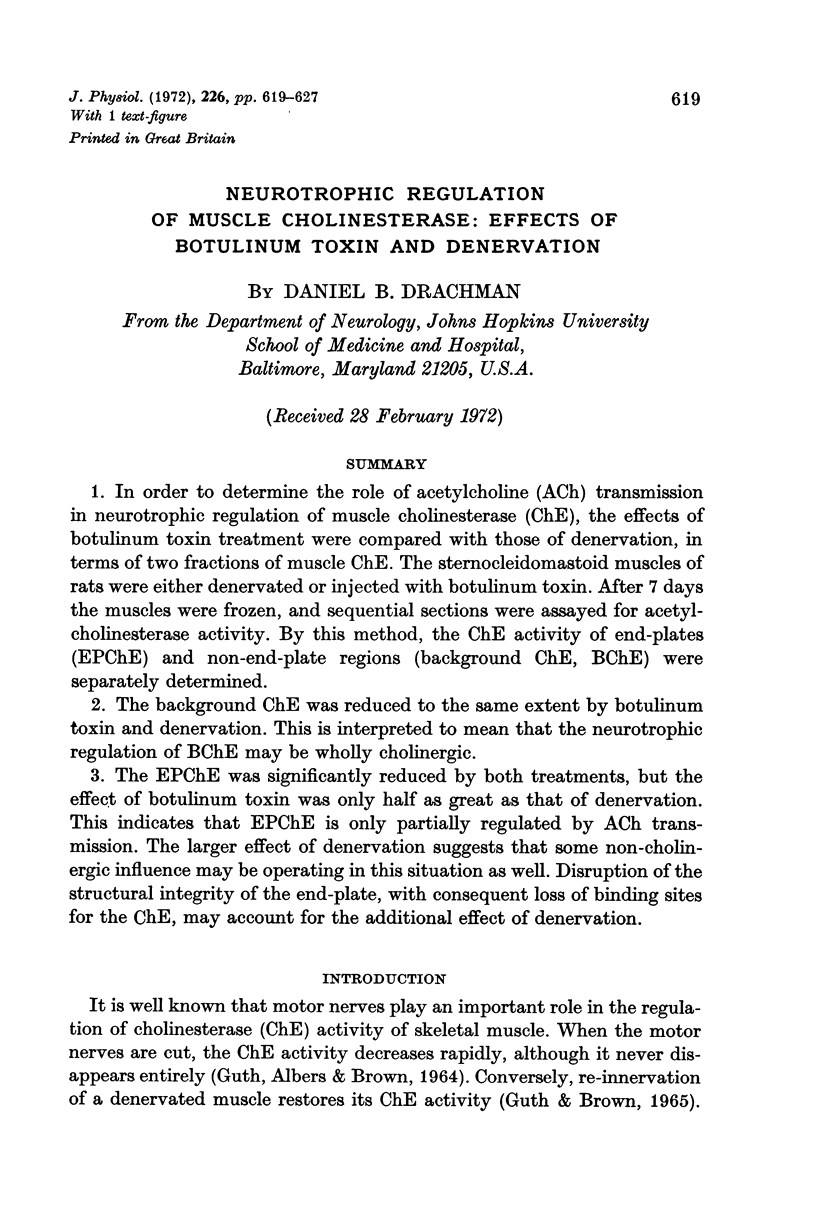
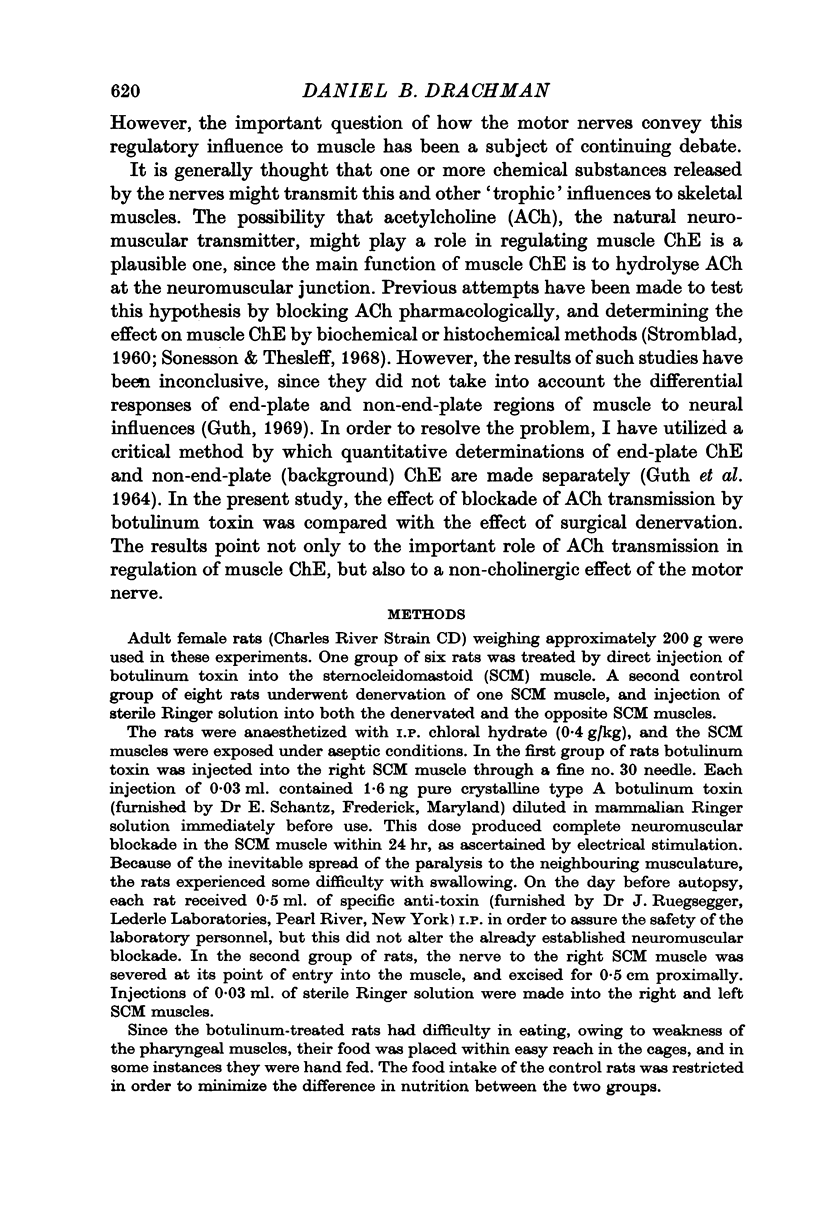
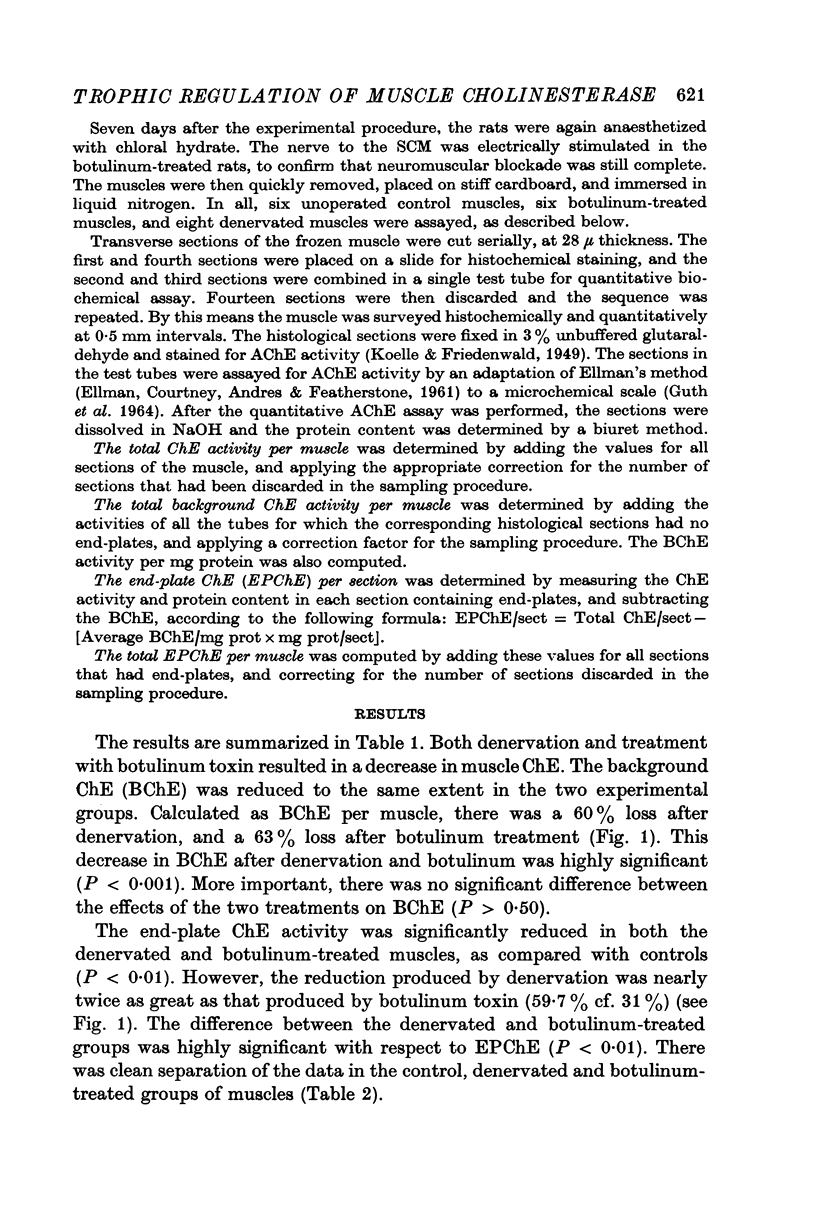

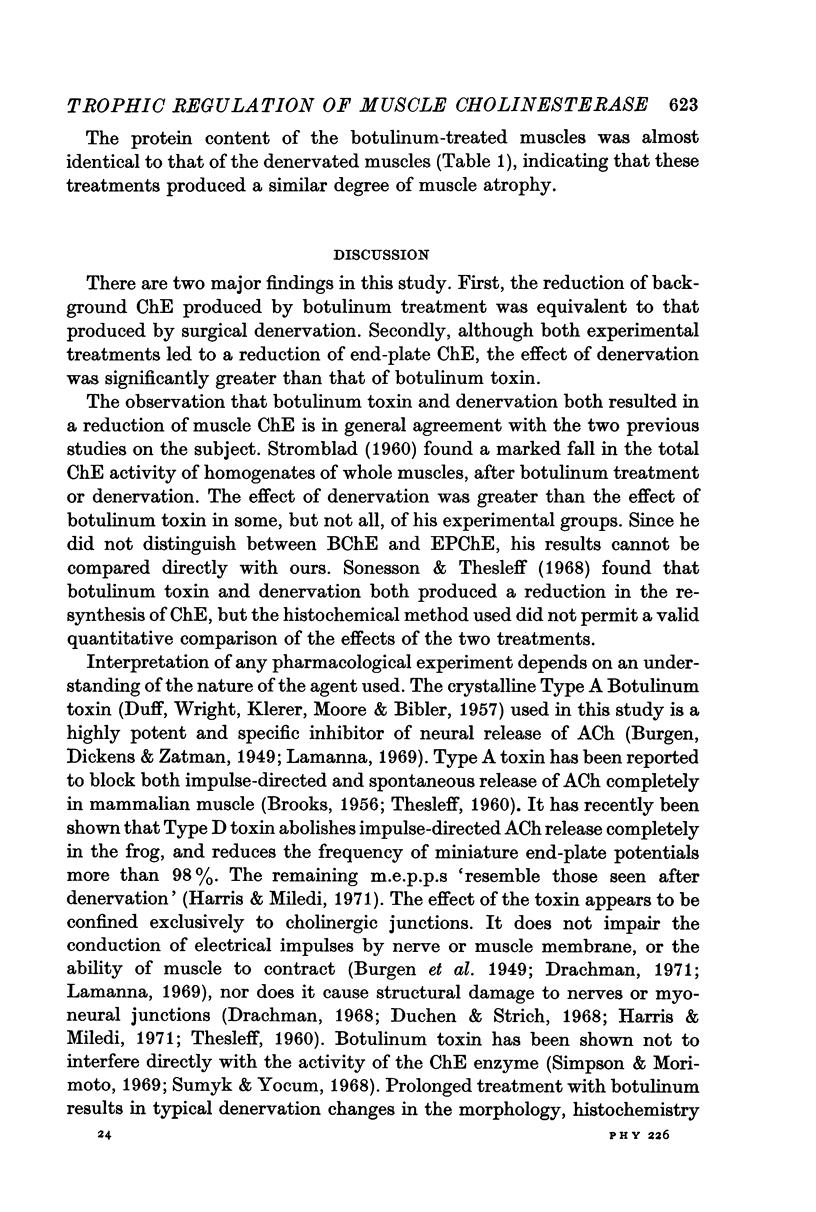


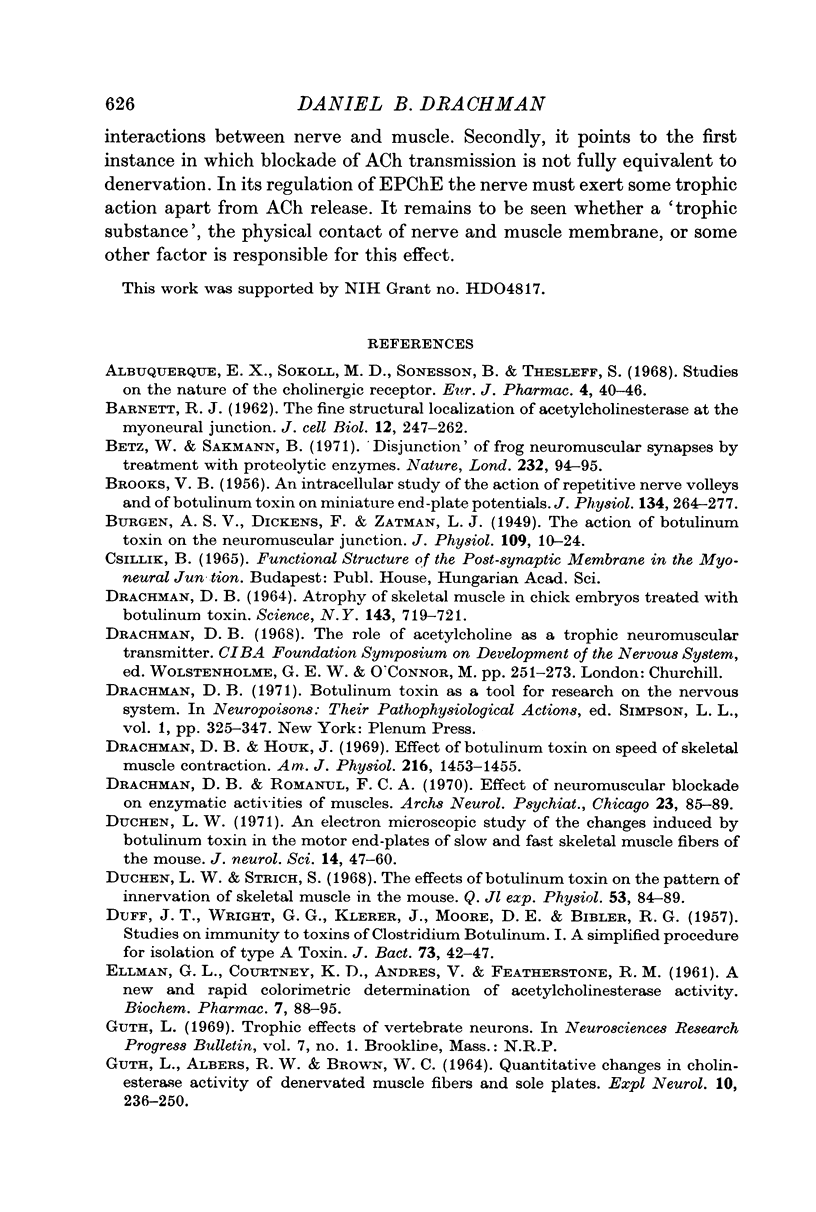
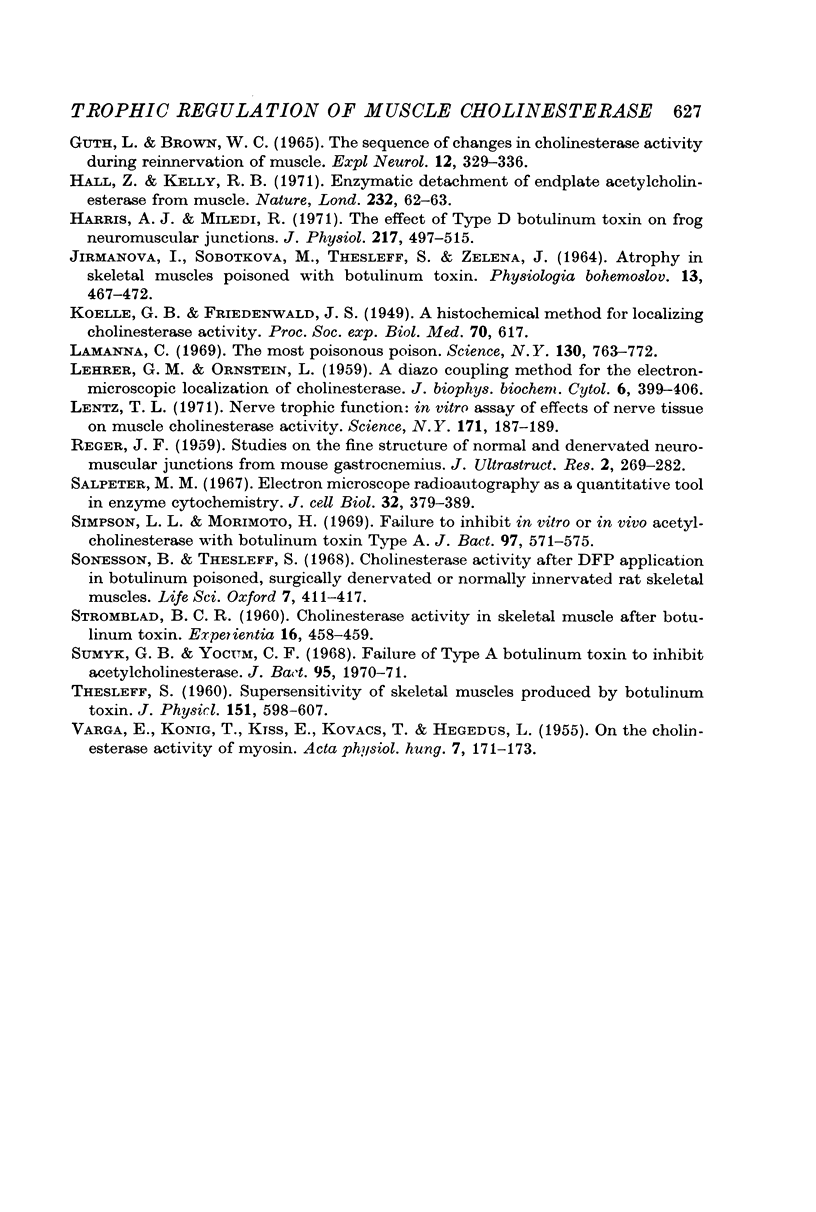
Selected References
These references are in PubMed. This may not be the complete list of references from this article.
- Albuquerque E. X., Sokoll M. D., Sonesson B., Thesleff S. Studies on the nature of the cholinergic receptor. Eur J Pharmacol. 1968 Aug;4(1):40–46. doi: 10.1016/0014-2999(68)90007-1. [DOI] [PubMed] [Google Scholar]
- BROOKS V. B. An intracellular study of the action of repetitive nerve volleys and of botulinum toxin on miniature end-plate potentials. J Physiol. 1956 Nov 28;134(2):264–277. doi: 10.1113/jphysiol.1956.sp005642. [DOI] [PMC free article] [PubMed] [Google Scholar]
- BURGEN A. S. V., DICKENS F., ZATMAN L. J. The action of botulinum toxin on the neuro-muscular junction. J Physiol. 1949 Aug;109(1-2):10–24. doi: 10.1113/jphysiol.1949.sp004364. [DOI] [PMC free article] [PubMed] [Google Scholar]
- Betz W., Sakmann B. "Disjunction" of frog neuromuscular synapses by treatment with proteolytic enzymes. Nat New Biol. 1971 Jul 21;232(29):94–95. doi: 10.1038/newbio232094a0. [DOI] [PubMed] [Google Scholar]
- DRACHMAN D. B. ATROPHY OF SKELETAL MUSCLE IN CHICK EMBRYOS TREATED WITH BOTULINUM TOXIN. Science. 1964 Aug 14;145(3633):719–721. doi: 10.1126/science.145.3633.719. [DOI] [PubMed] [Google Scholar]
- DUFF J. T., WRIGHT G. G., KLERER J., MOORE D. E., BIBLER R. H. Studies on immunity to toxins of Clostridium botulinum. I. A simplified procedure for isolation of type A toxin. J Bacteriol. 1957 Jan;73(1):42–47. doi: 10.1128/jb.73.1.42-47.1957. [DOI] [PMC free article] [PubMed] [Google Scholar]
- Drachman D. B., Houk J. Effect of botulinum toxin on speed of skeletal muscle contraction. Am J Physiol. 1969 Jun;216(6):1453–1455. doi: 10.1152/ajplegacy.1969.216.6.1453. [DOI] [PubMed] [Google Scholar]
- Drachman D. B., Romanul F. C. Effect of neuromuscular blockade on enzymatic activities of muscles. Arch Neurol. 1970 Jul;23(1):85–89. doi: 10.1001/archneur.1970.00480250089013. [DOI] [PubMed] [Google Scholar]
- Duchen L. W. An electron microscopic study of the changes induced by botulinum toxin in the motor end-plates of slow and fast skeletal muscle fibres of the mouse. J Neurol Sci. 1971 Sep;14(1):47–60. doi: 10.1016/0022-510x(71)90129-8. [DOI] [PubMed] [Google Scholar]
- Duchen L. W., Strich S. J. The effects of botulinum toxin on the pattern of innervation of skeletal muscle in the mouse. Q J Exp Physiol Cogn Med Sci. 1968 Jan;53(1):84–89. doi: 10.1113/expphysiol.1968.sp001948. [DOI] [PubMed] [Google Scholar]
- ELLMAN G. L., COURTNEY K. D., ANDRES V., Jr, FEATHER-STONE R. M. A new and rapid colorimetric determination of acetylcholinesterase activity. Biochem Pharmacol. 1961 Jul;7:88–95. doi: 10.1016/0006-2952(61)90145-9. [DOI] [PubMed] [Google Scholar]
- GUTH L., ALBERS R. W., BROWN W. C. QUANTITATIVE CHANGES IN CHOLINESTERASE ACTIVITY OF DENERVATED MUSCLE FIBERS AND SOLE PLATES. Exp Neurol. 1964 Sep;10:236–250. doi: 10.1016/0014-4886(64)90065-2. [DOI] [PubMed] [Google Scholar]
- GUTH L., BROWN W. C. THE SEQUENCE OF CHANGES IN CHOLINESTERASE ACTIVITY DURING REINNERVATION OF MUSCLE. Exp Neurol. 1965 Aug;12:329–336. doi: 10.1016/0014-4886(65)90076-2. [DOI] [PubMed] [Google Scholar]
- Hall Z. W., Kelly R. B. Enzymatic detachment of endplate acetylcholinesterase from muscle. Nat New Biol. 1971 Jul 14;232(28):62–63. doi: 10.1038/newbio232062a0. [DOI] [PubMed] [Google Scholar]
- Harris A. J., Miledi R. The effect of type D botulinum toxin on frog neuromuscular junctions. J Physiol. 1971 Sep;217(2):497–515. doi: 10.1113/jphysiol.1971.sp009582. [DOI] [PMC free article] [PubMed] [Google Scholar]
- JIRMANOVA I., SOBOTKOVA M., THESLEFF S., ZELENA J. ATROPHY IN SKELETAL MUSCLES POISONED WITH BOTULINUM TOXIN. Physiol Bohemoslov. 1964;13:467–472. [PubMed] [Google Scholar]
- LAMANNA C. The most poisonous poison. Science. 1959 Sep 25;130(3378):763–772. doi: 10.1126/science.130.3378.763. [DOI] [PubMed] [Google Scholar]
- LEHRER G. M., ORNSTEIN L. A diazo coupling method for the electron microscopic localization of cholinesterase. J Biophys Biochem Cytol. 1959 Dec;6:399–406. doi: 10.1083/jcb.6.3.399. [DOI] [PMC free article] [PubMed] [Google Scholar]
- Lentz T. L. Nerve trophic function: in vitro assay of effects of nerve tissue on muscle cholinesterase ctivity. Science. 1971 Jan 15;171(3967):187–189. doi: 10.1126/science.171.3967.187. [DOI] [PubMed] [Google Scholar]
- REGER J. F. Studies on the fine structure of normal and denervated neuromuscular junctions from mouse gastrocnemius. J Ultrastruct Res. 1959 Mar;2(3):269–282. doi: 10.1016/s0022-5320(59)80001-0. [DOI] [PubMed] [Google Scholar]
- Salpeter M. M. Electron microscope radioautography as a quantitative tool in enzyme cytochemistry. I. The distribution of acetylcholinesterase at motor end plates of a vertebrate twitch muscle. J Cell Biol. 1967 Feb;32(2):379–389. doi: 10.1083/jcb.32.2.379. [DOI] [PMC free article] [PubMed] [Google Scholar]
- Simpson L. L., Morimoto H. Failure to inhibit in vitro or in vivo acetycholinesterase with botulinum toxin type A. J Bacteriol. 1969 Feb;97(2):571–575. doi: 10.1128/jb.97.2.571-575.1969. [DOI] [PMC free article] [PubMed] [Google Scholar]
- Sonesson B., Thesleff S. Cholinesterase activity after DFP application in botulinum poisoned, surgically denervated or normally innervated rat skeletal muscles. Life Sci. 1968 Apr 1;7(7):411–417. doi: 10.1016/0024-3205(68)90012-x. [DOI] [PubMed] [Google Scholar]
- Sumyk G. B., Yocum C. F. Failure of type A botulinum toxin to inhibit acetylcholinesterase. J Bacteriol. 1968 May;95(5):1970–1971. doi: 10.1128/jb.95.5.1970-1971.1968. [DOI] [PMC free article] [PubMed] [Google Scholar]
- THESLEFF S. Supersensitivity of skeletal muscle produced by botulinum toxin. J Physiol. 1960 Jun;151:598–607. doi: 10.1113/jphysiol.1960.sp006463. [DOI] [PMC free article] [PubMed] [Google Scholar]
- VARGA E., KONIG T., KISS E., KOVACS T., HEGEDUS L. On the cholinesterase activity of myosin. Acta Physiol Acad Sci Hung. 1955;7(1-2):171–173. [PubMed] [Google Scholar]


